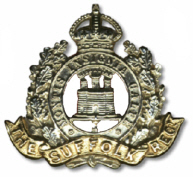



No.6977, Private, James DYER
Aged 28


An Old Contemptible
|
James Dyer was born in Brandon in 1886 (Thetford Q3-1886 4B:388), son of Henry William and Eliza DYER (née SHINN). 1891 census...Aged 5, he was at No 1 Grub Street, Brandon with his father Henry William DYER [26] stoke/driver for stationary engine; his mother Eliza [25]; sisters Elizabeth [7] and Julia [3]; brother Walter [1]. All were born in Brandon. 1901 census...Aged 14, labourer, he was at Stores Lane, Brandon with his parents (father now a labourer); sisters Elizabeth, Julia, Mildred [8], Eliza [5] and Annie [3]; brother Walter. The new sisters were all born in Brandon. 1911 census...Aged 24, a private in 1st battalion Suffolk Regiment he was at Mustapha Pasha Barracks, Alexandria, Egypt. His parents were at London Road,Brandon with his brother Walter (timber yard labourer); sisters Elizabeth, Eliza, Annie, Ada [8] and Eva [5]. His mother had borne 9 children but 3 had died. |

|
Enlisted in Bury St.Edmunds in the Militia on 8th September 1904 #6616. He gave his age as 18, born and lived in Brandon with his father Henry at Town Street.
he was 5 feet 5 inches ( 165.1 cm)tall, weighed 114 lbs (51.9 kg), chest 34" to 36" (86.4 to 91.4 cm), brown eyes and hair, Church of England. He had been working for Mr Shore at Elveden. On 5th June 1905 he transferred to the Regular Army. Unfortunately that is all that has survived of his Army records. As a regular in the Army he was of course one of the first to be sent to France and unfortunately he was one of the first Brandon men to die. The 2nd Battalion were in Dublin on the day war broke out, 4th August 1914, and by 10th they were ready to embark direct to France. Moving by marching and by train they eventually reached Mons on the 22nd. Then the German advance strengthened and the Retreat from Mons began for the British Army. By the evening of the 25th August the 2nd Suffolks were halted just outside Montay. After a brief halt they moved on, to Pont des Quatre Vaux, half a mile west of Le Cateau. On the 26th the order went out from Brigadier General Rolt that there was to be "no retreat...there is to be no thought of retirement". After six hours of continuous and overwhelming fire, they still held, but the Germans had mustered an massive force which nearly totally surrounded the British and by just before 3 the Argyll Highlanders and the Suffolks were overcome. A battalion in the British army was approximately 1,000 men and this day the 2nd Suffolks suffered 720 casualties of all ranks. The remnants slipped away and the next day, at dawn the roll call revealed the Battalion under command of Lt Oakes was 'A' Coy 31; 'B' Coy 19; 'C' Coy 38 and 'D' Coy 16 with 7 attached men, a total of 111. A few stragglers caught up later in the day. The dead numbered 74, only three have known graves. Numbers at this stage of the war are notoriously inaccurate. The Imperial War Graves Commission had not even been thought of. In fact the concept of even finding the dead and burying them individually was not generally known. Up to then it would have normally only been some officers buried individually or brought back to England. It took a man called Fabian Ware to start organising the currently accepted method of recording, and burying the dead, where possible, in individual graves. Norwich Mercury Saturday October 31 1914:- "Another Brandon Reservist, James Dyer, of the Suffolks, has been reported as missing, and his relatives, who live in London Road, have as yet received no tidings as to his whereabouts". click here to go to the Brandon at War website for more information
click here to go to the Commonwealth War Graves Commission website for full cemetery/memorial details |